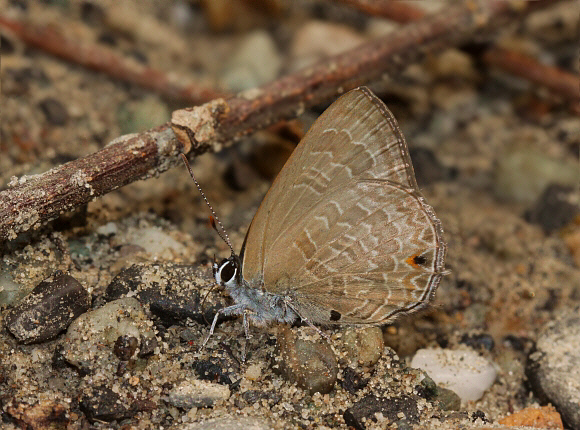
Introduction
Although tiny and inconspicuous, the Ciliate Blue is a fascinating species, being entirely dependent on a single species of ant for its survival.
The genus Anthene comprises of about 95 species, of which 80+ occur in tropical Africa, 5 or 6 in the Oriental region, and 5 in the Australian region.
The various Anthene species are commonly known as Ciliate Blues or Hairtails, due to the fact that the fine cilia or ‘hairs’ around the wing margins are drawn out into little tails at veins 1b, 2 and 3 on the hindwings. These short thin tails are normally only apparent on freshly emerged specimens however, and are lost after a day or two of activity.
Males of most species, on the upper surface of the wings, are a lustrous deep purple or indigo blue colour. Females are usually a dull earthy brown colour but often flushed with blue or purple around the base of the wings. Many of the species are difficult to tell apart, and can only be distinguished by studying small differences in the pattern on the underside of the wings.
Anthene emolus is a common and widespread species found from India and Sri Lanka to Thailand, Malaya, Sumatra, Borneo and Java.
Habitats
The butterfly breeds in disturbed primary and secondary forest habitats at altitudes between sea level and about 800m. It is commonly found along roadsides and riverbanks, and is often found close to habitations.

Lifecycle
The eggs are laid in batches of up to 150 on saplings of Saraca, Nephelium, Cassia, Heynea and other trees and bushes.
After hatching and eating their egg shells the tiny larvae are abducted by kerengga ants Oecophylla smaragdina, a large aggressive species that constructs its nests among living foliage on trees. The ants carry their captives into their nests, where they feed on the leaves, and possibly also on substances regurgitated by the ants.
The ants make no attempt to attack the caterpillars, presumably because they are able to placate them by using a chemical deterrent or possibly by means of an ‘appeasement song’ – research on several European ‘Blues’ has shown that their larvae and pupae are able to stridulate or ‘chirp’, and that this sound deters ants from attacking.
Research by Fiedler & Maschwitz has shown that the young 1st instar emolus caterpillars are unable to survive outside the ant nests, and will not feed on leaves outside the nest. This could be due to the warm humid microclimate within the ant nest, or due to a substance produced by the ants which softens the leaves and makes it easier for the caterpillars to digest them. Even odder is the fact that after the caterpillars moult to the 2nd instar, the ants then remove them from their nests, and carefully transport them to young sprigs of the foodplant some distance away.
A few days later when the caterpillars reach their 3rd instar they develop honey-producing glands on their backs, and they are constantly attended by the ants, which ‘milk’ them to drink the sugary secretion. The relationship is not truly symbiotic, because while the Anthene caterpillars cannot survive without the ants, the ants are able to obtain their ‘honey’ from other sources.
The chrysalis is usually formed some distance from the ant nest – any butterfly unlucky enough to find itself emerging near the nest is instantly attacked, torn into pieces, and carried to the ant nest for consumption.
Adult behaviour
Males are most commonly seen when aggregating with other Lycaenidae to imbibe mineralised moisture from river sandbanks, damp roads, boulders and other sources of sodium. When feeding they always hold their wings erect, but in cloudy or cool weather they will often bask on foliage with their wings held half open. Females are less conspicuous but can sometimes be found nectaring at Lantana or other flowering bushes.

